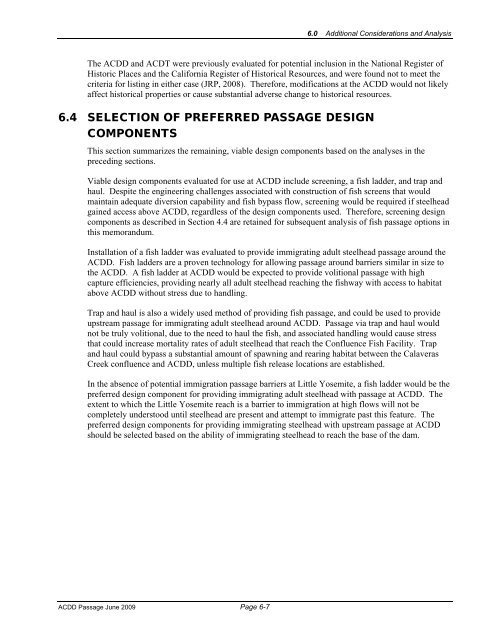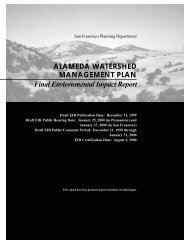<strong>Feasibility</strong> <strong>of</strong> <strong>Fish</strong> <strong>Passage</strong> <strong>at</strong> <strong>Alameda</strong> <strong>Creek</strong> <strong>Diversion</strong> <strong>Dam</strong>about 18 miles <strong>of</strong> accessible salmonid habit<strong>at</strong> (MMWD, 2007). During most years, the w<strong>at</strong>ershedsupports 8 to 16 steelhead redds per mile. Redds are concentr<strong>at</strong>ed in stream reaches where substr<strong>at</strong>eand flow are favorable. Localized redd densities within favorable reaches have been observed as highas 35 redds per mile during some years. Across different w<strong>at</strong>ersheds, redd density is highly variable,depending on individual river and stream characteristics. Maahs and Gilleard (1993) report th<strong>at</strong> foreight coastal Mendocino County streams, redd (assumed to be mostly steelhead) densities in Februaryrange from much less than 1 redd per mile up to approxim<strong>at</strong>ely 5 redds per mile. Steelhead reddsurveys in the much larger, interior Fe<strong>at</strong>her River <strong>of</strong> California during 2003 indic<strong>at</strong>ed redd counts <strong>of</strong>36 per mile, with nearly all redds concentr<strong>at</strong>ed within a few miles <strong>of</strong> the river system (DWR, 2003).Based on these d<strong>at</strong>a, future steelhead redd density above ACDD is estim<strong>at</strong>ed to have a potential rangefrom 1 to 35 per mile.Given the above estim<strong>at</strong>e <strong>of</strong> between 4 and 10 miles <strong>of</strong> potentially suitable steelhead habit<strong>at</strong> aboveACDD, and the expect<strong>at</strong>ion <strong>of</strong> between 1 and 35 redds per mile, the habit<strong>at</strong> above ACDD may becapable <strong>of</strong> supporting between 4 (1 redd/mile × 4 miles <strong>of</strong> habit<strong>at</strong>) and 350 (35 redds/mile × 10 miles<strong>of</strong> habit<strong>at</strong>) steelhead redds annually, with the actual value likely lying somewhere in between. Basedon this estim<strong>at</strong>e, it may be possible for habit<strong>at</strong> above ACDD to sustain a popul<strong>at</strong>ion <strong>of</strong> steelhead (seeAppendix C). If the quantity and quality <strong>of</strong> habit<strong>at</strong> above ACDD are insufficient to independentlysustain a popul<strong>at</strong>ion <strong>of</strong> steelhead, then it is likely sufficient to sustain a subpopul<strong>at</strong>ion large enough tocontribute to a steelhead metapopul<strong>at</strong>ion in the <strong>Alameda</strong> <strong>Creek</strong> W<strong>at</strong>ershed, if subpopul<strong>at</strong>ions are alsoestablished <strong>at</strong> other loc<strong>at</strong>ions.6.3 ENVIRONMENTAL CONSIDERATIONSThis section summarizes non-steelhead environmental consider<strong>at</strong>ions including biology, wetlands,and cultural resources rel<strong>at</strong>ed to fish passage <strong>at</strong> ACDD. Construction and oper<strong>at</strong>ion <strong>of</strong> fish passagewould result in some unavoidable adverse environmental impacts. Such impacts are typical whenconstructing nearly any type <strong>of</strong> project in n<strong>at</strong>ural lands in California, and should not be consideredprohibitive, but this would certainly add to the overall cost <strong>of</strong> providing fish passage. In addition toevalu<strong>at</strong>ing the design components as in the previous sections, the environmental impacts associ<strong>at</strong>edwith construction and oper<strong>at</strong>ion <strong>of</strong> the different design components also should be considered beforeimplementing fish passage. Impacts may require permitting, minimiz<strong>at</strong>ion, and mitig<strong>at</strong>ion.While the specific impacts <strong>of</strong> fish passage as evalu<strong>at</strong>ed in this technical memorandum would beaddressed separ<strong>at</strong>ely in specific permitting documents, the types <strong>of</strong> impacts th<strong>at</strong> could potentiallyoccur could include:■■■■Interference with the movement <strong>of</strong> resident fish species;Some localized placement <strong>of</strong> fill in jurisdictional w<strong>at</strong>ers <strong>of</strong> the United St<strong>at</strong>es, including wetlands,th<strong>at</strong> are regul<strong>at</strong>ed under the federal Clean W<strong>at</strong>er Act, to construct fish passage facilities andinfrastructure;Limited loss or degrad<strong>at</strong>ion <strong>of</strong> riparian habit<strong>at</strong>s regul<strong>at</strong>ed by the CDFG under the <strong>Fish</strong> and GameCode <strong>at</strong> loc<strong>at</strong>ions where facilities are constructed; andLimited loss or degrad<strong>at</strong>ion <strong>of</strong> habit<strong>at</strong>s th<strong>at</strong> are potentially used by special st<strong>at</strong>us species(federally or st<strong>at</strong>e-listed, or st<strong>at</strong>e species <strong>of</strong> concern), including the California red-legged frog, thefoothill yellow-legged frog, the California tiger salamander, and <strong>at</strong> least one species <strong>of</strong> b<strong>at</strong> <strong>at</strong>loc<strong>at</strong>ions where facilities are constructed or roadwork is required.ACDD <strong>Passage</strong> June 2009 Page 6-6
6.0 Additional Consider<strong>at</strong>ions and AnalysisThe ACDD and ACDT were previously evalu<strong>at</strong>ed for potential inclusion in the N<strong>at</strong>ional Register <strong>of</strong>Historic Places and the California Register <strong>of</strong> Historical Resources, and were found not to meet thecriteria for listing in either case (JRP, 2008). Therefore, modific<strong>at</strong>ions <strong>at</strong> the ACDD would not likelyaffect historical properties or cause substantial adverse change to historical resources.6.4 SELECTION OF PREFERRED PASSAGE DESIGNCOMPONENTSThis section summarizes the remaining, viable design components based on the analyses in thepreceding sections.Viable design components evalu<strong>at</strong>ed for use <strong>at</strong> ACDD include screening, a fish ladder, and trap andhaul. Despite the engineering challenges associ<strong>at</strong>ed with construction <strong>of</strong> fish screens th<strong>at</strong> wouldmaintain adequ<strong>at</strong>e diversion capability and fish bypass flow, screening would be required if steelheadgained access above ACDD, regardless <strong>of</strong> the design components used. Therefore, screening designcomponents as described in Section 4.4 are retained for subsequent analysis <strong>of</strong> fish passage options inthis memorandum.Install<strong>at</strong>ion <strong>of</strong> a fish ladder was evalu<strong>at</strong>ed to provide immigr<strong>at</strong>ing adult steelhead passage around theACDD. <strong>Fish</strong> ladders are a proven technology for allowing passage around barriers similar in size tothe ACDD. A fish ladder <strong>at</strong> ACDD would be expected to provide volitional passage with highcapture efficiencies, providing nearly all adult steelhead reaching the fishway with access to habit<strong>at</strong>above ACDD without stress due to handling.Trap and haul is also a widely used method <strong>of</strong> providing fish passage, and could be used to provideupstream passage for immigr<strong>at</strong>ing adult steelhead around ACDD. <strong>Passage</strong> via trap and haul wouldnot be truly volitional, due to the need to haul the fish, and associ<strong>at</strong>ed handling would cause stressth<strong>at</strong> could increase mortality r<strong>at</strong>es <strong>of</strong> adult steelhead th<strong>at</strong> reach the Confluence <strong>Fish</strong> Facility. Trapand haul could bypass a substantial amount <strong>of</strong> spawning and rearing habit<strong>at</strong> between the Calaveras<strong>Creek</strong> confluence and ACDD, unless multiple fish release loc<strong>at</strong>ions are established.In the absence <strong>of</strong> potential immigr<strong>at</strong>ion passage barriers <strong>at</strong> Little Yosemite, a fish ladder would be thepreferred design component for providing immigr<strong>at</strong>ing adult steelhead with passage <strong>at</strong> ACDD. Theextent to which the Little Yosemite reach is a barrier to immigr<strong>at</strong>ion <strong>at</strong> high flows will not becompletely understood until steelhead are present and <strong>at</strong>tempt to immigr<strong>at</strong>e past this fe<strong>at</strong>ure. Thepreferred design components for providing immigr<strong>at</strong>ing steelhead with upstream passage <strong>at</strong> ACDDshould be selected based on the ability <strong>of</strong> immigr<strong>at</strong>ing steelhead to reach the base <strong>of</strong> the dam.ACDD <strong>Passage</strong> June 2009 Page 6-7








